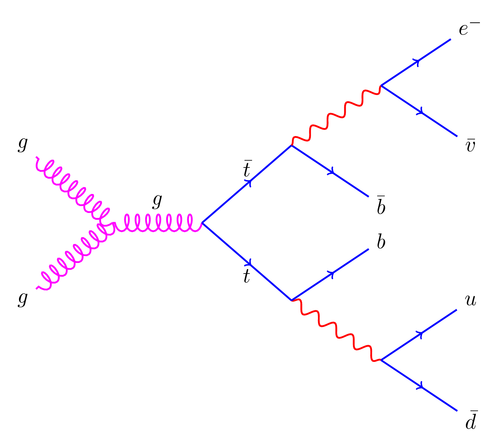I saw this Feynman diagram in Edward Tufte's book Beautiful evidence (you can also find it in this thread). It was relatively easy to recreate using trees and decorations.
Update: Rewritten using PGF 2.0 features.

Edit and compile if you like:
% Feynman diagram
% Requires PGF >= 2.0
\documentclass{article}
\usepackage[latin1]{inputenc}
\usepackage{tikz}
\usetikzlibrary{trees}
\usetikzlibrary{decorations.pathmorphing}
\usetikzlibrary{decorations.markings}
\begin{document}
% Define styles for the different kind of edges in a Feynman diagram
\tikzset{
photon/.style={decorate, decoration={snake}, draw=red},
electron/.style={draw=blue, postaction={decorate},
decoration={markings,mark=at position .55 with {\arrow[draw=blue]{>}}}},
gluon/.style={decorate, draw=magenta,
decoration={coil,amplitude=4pt, segment length=5pt}}
}
\begin{tikzpicture}[
thick,
% Set the overall layout of the tree
level/.style={level distance=1.5cm},
level 2/.style={sibling distance=2.6cm},
level 3/.style={sibling distance=2cm}
]
\coordinate
child[grow=left]{
child {
node {$g$}
% The 'edge from parent' is actually not needed because it is
% implicitly added.
edge from parent [gluon]
}
child {
node {$g$}
edge from parent [gluon]
}
edge from parent [gluon] node [above=3pt] {$g$}
}
% I have to insert a dummy child to get the tree to grow
% correctly to the right.
child[grow=right, level distance=0pt] {
child {
child {
child {
node {$\bar{d}$}
edge from parent [electron]
}
child {
node {$u$}
edge from parent [electron]
}
edge from parent [photon]
}
child {
node {$b$}
edge from parent [electron]
}
edge from parent [electron]
node [below] {$t$}
}
child {
child {
node {$\bar{b}$}
edge from parent [electron]
}
child {
child {
node {$\bar{v}$}
edge from parent [electron]
}
child {
node {$e^{-}$}
edge from parent [electron]
}
edge from parent [photon]
}
edge from parent [electron]
node [above] {$\bar{t}$}
}
};
\end{tikzpicture}
\end{document}Click to download: feynman-diagram.tex • feynman-diagram.pdf
Open in Overleaf: feynman-diagram.tex


